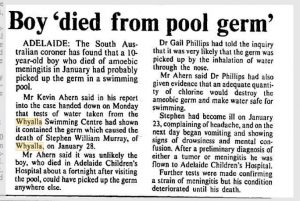Whyalla (South Australia) – pH (alkaline)
Average pH: 2016 July-2017 June Cowled Avenue: 8.742 pH units
Average pH: 2016 July-2017 June Bailey Street: 8.767 pH units
Average pH: 2016 July-2017 June Noorie Avenue: 8.717 pH units
Average pH: 2016 July-2017 June Broadbent Terrace: 8.725 pH units
Average pH: 2016 July-2017 June Jackson Avenue: 8.742 pH units
Average pH: 2016 July-2017 June Gowrie Avenue: 8.708 pH units
Average pH: 2016 July-2017 June Flinders Street: 8.717 pH units
Average pH: 2016 July-2017 June Saddleback Road: 8.908 pH units
2018/19: Whyalla – Flinders Street (South Australia) 8.9 pH units
2019/20: Whyalla pH (average) 8.94pH units
2022/23: Whyalla – Flinders Street pH (average) 8.769pH units
Based on the need to reduce corrosion and encrustation in pipes and fittings, the pH of
drinking water should be between 6.5 and 8.5.
New concrete tanks and cement-mortar lined pipes can significantly increase pH and
a value up to 9.2 may be tolerated, provided monitoring indicates no deterioration in
microbiological quality.
pH is a measure of the hydrogen ion concentration of water. It is measured on a logarithmic scale from 0 to 14. A pH of 7 is neutral, greater than 7 is alkaline, and less than 7 is acidic.
One of the major objectives in controlling pH is to minimise corrosion and encrustation in pipes and fittings. Corrosion can be reduced by the formation of a protective layer of calcium carbonate on the inside of the pipe or fitting, and the formation of this layer is affected by pH, temperature, the availability of calcium (hardness) and carbon dioxide. If the water is too alkaline (above pH 8.5), the rapid deposition and build-up of calcium carbonate that can result may eventually block the pipe.
When pH is below 6.5 or above 11, the water may corrode plumbing fittings and pipes. This, however, will depend on other factors such as the material used, the concentration and type of ions in solution, the availability of oxygen, and the water temperature. Under some conditions, particularly in the presence of strong oxidising agents such as chlorine, water with a pH between 6.5 and 7 can be quite corrosive.
Chlorine disinfection efficiency is impaired above pH 8.0, although the optimum pH for monochloramine disinfectant formation is between 8.0 and 8.4. In chloraminated supplies chlorine can react with ammonia to form odorous nitrogen trichloride below pH 7.
Chlorination of water supplies can decrease the pH, while it can be significantly raised by lime leached from new concrete tanks or from pipes lined with asbestos cement or cement mortar. Values of pH above 9.5 can cause a bitter taste in drinking water, and can irritate skin if the water is used for ablutions.
1981 Whyalla – naegleria fowleri
Source: Indaily December 12 2019

Meanwhile, SA Water continues to charge for bore water unfit for human consumption and which it says may contain naegleria fowleri – a microorganism it frequently tests for and which causes a very rare but almost always fatal brain infection.
Even boiling the water, which is sourced from two bores tapped into the Great Artesian Basin, will not make it safe to drink.
The infection – called primary amoebic meningoencephalitis – causes the rapid destruction of brain tissue, promoting nausea, hallucinations, high fever and eventually, death.
According to SA Health records, the infection was last detected in Whyalla in 1981 following the death of a ten-year-old boy.
SA Water told InDaily naegleria fowleri has never been detected in Oodnadatta’s water supply, but a risk of contamination has prompted it to issue repeated warnings to the town’s approximate 200 residents.
“The microorganism, naegleria fowleri, may be present in your non-drinking water supply,” a SA Water guide distributed to Oodnadatta residents and businesses says.
“Avoid swallowing water or allowing water to go up your nose when showering, bathing or using sinus irrigation products with unboiled water.
“Children must avoid swallowing water or getting water up their nose when bathing or playing with water, including using a hose or a paddling pool.”